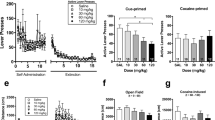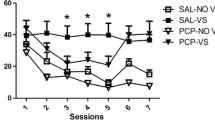Abstract
Rationale
Most nicotine self-administration (NSA) studies in rats are performed under limited-access conditions. Few studies have examined the relationship between nicotine dependence and NSA.
Objectives
To determine how NSA access conditions affect NSA and the duration of nicotine dependence during abstinence, as reflected in somatic signs of withdrawal precipitated by administration of the nicotinic receptor antagonist mecamylamine.
Methods
The effects of different NSA access conditions (zero, 1 h/5 days, 1 h/7 days and 6 h/7 days per week) and non-contingent nicotine administration on NSA and somatic signs were examined.
Results
Daily NSA access (30 days) resulted in spontaneous and mecamylamine-induced somatic signs. Both daily access groups (1 h/day and 6 h/day, 7 days/week) exhibited spontaneous somatic signs on day 25 of NSA (17 h post-NSA) and sensitivity to mecamylamine up to 2 and 4 weeks of abstinence, respectively. In contrast, the 1 h/day, 5 days/week access group exhibited mecamylamine-induced somatic signs only up to 1 week of abstinence. NSA behavior was stable in rats with 1 h/day 5 days/week and 1 h/day 7 days/week access, but decreased from initially high rates in the 6 h/day 7 days/week access group, and decreased in rats receiving non-contingent nicotine. In contrast, extended cocaine self-administration access resulted in a gradual escalation in cocaine intake.
Conclusion
There was no escalation in nicotine intake with extended access conditions, unlike cocaine self-administration. Nevertheless, daily nicotine self-administration seven days per week, for either 1 or 6 h per day, was sufficient to induce long-lasting adaptations in nicotinic acetylcholine receptor activity reflected in spontaneous and antagonist-precipitated somatic signs of withdrawal, possibly reflecting aspects of nicotine dependence.




Similar content being viewed by others
References
Ahmed SH, Koob GF (1998) Transition from moderate to excessive drug intake: change in hedonic set point. Science 282:298–300
Ahmed SH, Koob GF (1999) Long-lasting increase in the set point for cocaine self-administration after escalation in rats. Psychopharmacology 146:303–312
Ahmed SH, Walker JR, Koob GF (2000) Persistent increase in the motivation to take heroin in rats with a history of drug escalation. Neuropsychopharmacology 22:413–421
Ahmed SH, Kenny PJ, Koob GF, Markou A (2002) Neurobiological evidence for hedonic allostasis associated with escalating cocaine use. Nature Neurosci 5:625–626
American Psychiatric Association (1994) Diagnostic and statistical manual of mental disorders, 4th edn. American Psychiatric Press, Washington D.C.
Benowitz NL, Zevin S, Jacob P 3rd (1998) Suppression of nicotine intake during ad libitum cigarette smoking by high-dose transdermal nicotine. J Pharmacol Exp Ther 287:958–962
Benwell MEM, Balfour DJK, Anderson JM (1988) Evidence that tobacco smoking increases the density of (−)-[3H]-nicotine binding sites in human brain. J Neurochem 50:1243–1247
Benwell MEM, Balfour DJK, Birrell CE (1995) Desensitization of the nicotine-induced mesolimbic dopamine responses during constant infusion with nicotine. Br J Pharmacol 114:454–460
Brower VG, Fu Y, Matta SG, Sharp BM (2002) Rat strain differences in nicotine self-administration using an unlimited access paradigm. Brain Res 930:12–20
Buisson B, Bertrand D (2001) Chronic exposure to nicotine upregulates the human α4β2 nicotinic acetylcholine receptor function. J Neurosci 21:1819–1829
Carboni E, Bortone L, Giua C, Di Chiara G (2000) Dissociation of physical abstinence signs from changes in extracellular dopamine in the nucleus accumbens and in the prefrontal cortex of nicotine dependent rats. Drug Alcohol Depend 58:93–102
Collins AC, Luo Y, Selvaag S, Marks MJ (1994) Sensitivity to nicotine and brain nicotinic receptors are altered by chronic nicotine and mecamylamine infusion. J Pharmacol Exp Ther 271:125–133
Corrigall WA, Coen KM (1989) Nicotine maintains robust self-administration in rats on a limited access schedule. Psychopharmacology 99:473–478
Cox BM, Goldstein A, Nelson WT (1984) Nicotine self-administration in rats. Br J Pharmacol 83:49–55
Cryan JF, Bruijnzeel AW, Skjei KL, Markou A (2003) Bupropion enhances brain reward function and reverses the affective and somatic aspects of nicotine withdrawal in the rat. Psychopharmacology 168:347–358
Dani JA, Heinemann S (1996) Molecular and cellular aspects of nicotine abuse. Neuron 16:905–908
Doherty K, Kinnunen T, Militello FS, Garvey AJ (1995) Urges to smoke during the first month of abstinence: relationship to relapse and predictors. Psychopharmacology 119:171–178
Donny EC, Caggiula AR, Knopf S, Brown C (1995) Nicotine self-administration in rats. Psychopharmacology 122:390–394
Donny EC, Caggiula AR, Rose C, Jacobs KS, Mielke MM, Sved AF (2000) Differential effects of response-contingent and response-independent nicotine in rats. Eur J Pharmacol 402:231–240
Epping-Jordan MP, Watkins SS, Koob GF, Markou A (1998) Dramatic decreases in brain reward function during nicotine withdrawal. Nature 393:76–79
Fu Y, Matta SG, Brower VG, Sharp BM (2001) Norepinephrine secretion in the hypothalamic paraventricular nucleus of rats during unlimited access to self-administered nicotine: an in vivo microdialysis study. J Neurosci 21:8979–8989
Goldberg SR, Spealman RD, Goldberg DM (1981) Persistent behavior at high rates maintained by intravenous self-administration of nicotine. Science 214:573–575
Harrison AA, Liem Y, Markou A (2001) Fluoxetine combined with a serotonin-1A receptor antagonist reversed reward deficits observed during nicotine and amphetamine withdrawal in rats. Neuropsychopharmacology 25:55–71
Hildebrand BE, Nomikos GG, Bondjers C, Nisell M, Svensson TH (1997) Behavioral manifestations of the nicotine abstinence syndrome in the rat: peripheral versus central mechanisms. Psychopharmacology 129:348–356
Hughes JR, Gust SW, Keenan RM, Fenwick JW (1990) Effect of dose on nicotine’s reinforcing, withdrawal-suppression and self-reported effects. J Pharmacol Exp Ther 252:1175–1183
Hughes JR, Gust SW, Skoog K, Keenan RM, Fenwick JW (1991) Symptoms of tobacco withdrawal: a replication and extension. Arch Gen Psychiatry 48:52–59
Isola R, Zhang H, Duchemin AM, Tejwani GA, Neff NH, Hadjiconstantinou M (2002) Met-enkephalin and preproenkephalin mRNA changes in the striatum of the nicotine abstinence mouse. Neurosci Lett 325:67–71
LeSage MG, Keyler DE, Shoeman D, Raphael D, Collins G, Pentel PR (2002) Continuous nicotine infusion reduces nicotine self-administration in rats with 23 h/day access to nicotine. Pharmacol Biochem Behav 72:279–289
Malin DH (2001) Nicotine dependence: studies with a laboratory model. Pharmacol Biochem Behav 70:551–559
Malin DH, Lake JR, Newlin-Maultsby P, Roberts LK, Lanier JG, Carter VA, Cunningham JS, Wilson OB (1992) Rodent model of nicotine abstinence syndrome. Pharmacol Biochem Behav 43:777–784
Markou A, Paterson NE (2001) The nicotinic antagonist methyllycaconitine has differential effects on nicotine self-administration and nicotine withdrawal in the rat. Nicotine Tobacco Res 3:361–373
Marks MJ, Burch JB, Collins AC (1983) Effects of chronic nicotine infusion on tolerance development and nicotinic receptors. J Pharmacol Exp Ther 226:817–825
Martin TJ, Suchocki J, May EL, Martin BR (1990) Pharmacological evaluation of the antagonism of nicotine’s central effects by mecamylamine and pempidine. J Pharmacol Exp Ther 254:45–51
McNeill AD, Jarvis MJ, Stapleton JA, West RJ, Bryant A (1989) Nicotine intake in young smokers: longitudinal study of saliva cotinine concentrations. Am J Public Health 79:172–175
National Institutes of Health (1996) Guide for the care and use of laboratory animals. National Academy Press, Washington, D.C.
Nemeth-Coslett R, Henningfield JE, O’Keefe MK, Griffiths RR (1986) Effects of mecamylamine on human cigarette smoking and subjective ratings. Psychopharmacology 88:420–425
Paterson NE, Markou A (2002) Increased GABA neurotransmission via administration of gamma-vinyl GABA decreased nicotine self-administration in the rat. Synapse 44:252–253
Picciotto MR, Zoli M, Rimondini R, Lena C, Marubio LM, Merlo Pich E, Fuxe K Changeux J-P (1998) Acetylcholine receptors containing the β2 subunit are involved in the reinforcing properties of nicotine. Nature 391:173–177
Risner ME, Goldberg SR (1983) A comparison of nicotine and cocaine self-administration in the dog: fixed-ratio and progressive-ratio schedules of intravenous drug infusion. J Pharmacol Exp Ther 224:319–326
Rowell PP, Li M (1997) Dose-response relationship for nicotine-induced up-regulation of rat brain nicotine receptors. J Neurochem 68:1982–1989
Semenova S, Markou A (2003) Clozapine treatment attenuated somatic and affective signs of nicotine and amphetamine withdrawal in subsets of rats exhibiting hyposensitivity to the initial effects of clozapine. Biol Psychiatry 54:1249–1264
Semenova S, Bespalov A, Markou A (2003) Decreased prepulse inhibition during nicotine withdrawal in DBA/2J mice is reversed by nicotine self-administration. Eur J Pharmacol 472:99–110
Shoaib M, Schindler CW, Goldberg SR (1997) Nicotine self-administration in rats: strain and nicotine pre-exposure effects on acquisition. Psychopharmacology 129:35–43
Skjei KL, Markou A (2003) Effects of repeated withdrawal episodes, nicotine dose, and duration of nicotine exposure on the severity and duration of nicotine withdrawal in rats. Psychopharmacology 168:280–292
Stolerman IP, Jarvis MJ (1995) The scientific case that nicotine is addictive Psychopharmacology 117:2–10
Stolerman IP, Goldfarb T, Fink R, Jarvik ME (1973) Influencing cigarette smoking with nicotine antagonists. Psychopharmacologia 28:247–259
Valentine JD, Hokanson JS, Matta SG, Sharp BM (1997) Self-administration in rats allowed unlimited access to nicotine. Psychopharmacology 133:300–304
Watkins SS, Epping-Jordan MP, Koob GF, Markou A (1999) Blockade of nicotine self-administration with nicotinic antagonists in rats. Pharmacol Biochem Behav 62:743–751
Watkins SS, Stinus L, Koob GF, Markou A (2000) Reward and somatic changes during precipitated nicotine withdrawal in rats: centrally and peripherally mediated effects. J Pharmacol Exp Ther. 292:1053–1064
Winer BJ (1971) Statistical principles in experimental design, 2nd edn. McGraw-Hill, New York
Acknowledgements
This is publication number 15655-NP from The Scripps Research Institute. The authors gratefully acknowledge technical support from Jessica Chevrette and Robert Lintz, and editorial assistance from Michael Arends. This study was supported by NIDA grant DA11946, NIDA/NIMH grant U01 MH69062, Tobacco-Related Disease Research Program Grant 12RT-0231 from the State of California, and a Novartis Research Grant to A.M.
Author information
Authors and Affiliations
Corresponding author
Rights and permissions
About this article
Cite this article
Paterson, N.E., Markou, A. Prolonged nicotine dependence associated with extended access to nicotine self-administration in rats. Psychopharmacology 173, 64–72 (2004). https://doi.org/10.1007/s00213-003-1692-7
Received:
Accepted:
Published:
Issue Date:
DOI: https://doi.org/10.1007/s00213-003-1692-7




